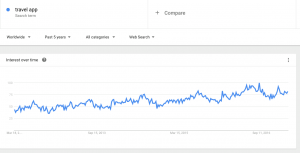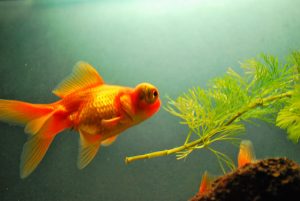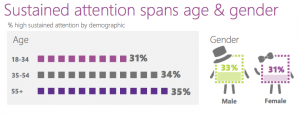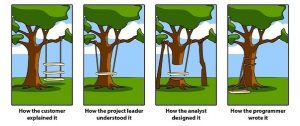app
Top Travel Apps of 2017.
Agile versus Waterfall
Figure 1. How Projects Really Work
In this post, we would like to discuss how we envision our development process philosophy and which approach we plan to use. As can be seen in Fig.1, the vision of a project is not always the same (completely different) to its final release. Thus, it is very important to choose the appropriate development strategy and stick to it during the project’s lifecycle to deliver the best solutions.
Different approaches
In the case of web development process, there are generally two approaches: waterfall and agile. What are the main differences between them?
- Waterfall process is when each part of the project is done sequentially by a team member and passed along the assembly line after the part is finished.
- Agile process is a simultaneous working approach when each member of a team contributes to the project in the same time frame.
In short, here is a simple explanation of both:
Video 1. Workflows: Agile vs. Waterfall
After considering the pros and cons of given approaches, we chose the agile model for the following reasons:
- Short iterations (time frames) of development work mean fast delivery and constant up-to-date with current issues. Our product is for young and innovative people and we need fast solutions for emerging problems, and small increments of work provide convenient development pace for our product.
- Our small team has representatives from all stakeholders, so conducting Scrum meetings would be an efficient collaborative process where interests from each side are not neglected.
- Feedback is prompt and corresponds with each iteration directly.
Q. How does it work on a daily basis?
A. Scrum Power!
Video 2. Short explanation how Scrums work
We will be using the Scrum Agile methodology as it has proved to be effective and applicable to various project types.
Basically, each of our sprints (a specialized term for iterations) will consist of several steps:
- A product owner –> creates –> a to-do list with noted priorities which is a product backlog.
- The team –>takes–> a small piece of that to-do list from the top, and discusses implementation.
- Our sprints –>last–> 3 to 4 weeks to complete that piece.
- Meanwhile, the team—> has –> daily scrum meetings to discuss and assess the progress of work to be done.
- The ScrumMaster —>is–> the master brain behind those organised scrum meetings. They keep the team aligned and focused on the goals.
- Each sprint —>ends —> with a deliverable product, thus showing an achieved goal to a stakeholder.
- A sprint review and retrospective —> complete the cycle of each sprint and maximise the feedback effect in order to improve a next sprint delivery.
- A new chunk of backlog is taken into work and the iteration cycle starts from Step 1.
In our vision, Scrum is a flexible and efficient web project management framework which enables the team to react more quickly and respond more accurately to the arising issues. Scrum’s holistic nature minimizes marginal risks and allows our App product to adapt to changes just in the right time.
Competitive Analysis
Competitive Analysis
In designing this App, JAMR carried out a competitive analysis of the market as part of risk mitigation and identifying a gap in the market, in order to get a solid footing in the market and prepare for expansion.
Defining the Competition
The first step was to define the competition; any app that is providing a similar service to NaviGap. This was carried out by a search engine queries and App store search, using keywords specific to our app and the word ‘app’ in the search terms. For example: ‘travel app’, ‘gap year app’, ‘travel community app’, ‘travel planning app’ and then compiling a list of competitors.

Compare Products
Comparing our product to the competitors and by understanding our competitors, their product and market advantages will ensure we don’t end up going head-to-head with a competitor on their strong points. We identified every product feature that each of our competitors offers and then looked at their web-presence by searching the URL on Alexa to view their visitor traffic ranking. Their social presence was identified by pasting their social media URL’s into the Wildfire monitor page and getting a preview of their social media presence.
Value
Researching what value our competitors are offering and what value is unique is an important facet of competition. There are generally certain value offerings that are an expectation of customers within an industry such as being ‘bug-free’, therefore we are only interested in the unique value offered. Don’t use these as our ‘point of difference’.
SWOT analysis
A SWOT analysis is the breakdown of our competitors perceived strengths, weaknesses, and what opportunities that this creates for us and what potential threats are presented. Using this information allows us to create something that’s unique in its own right. When looking at the competitor apps, we asked ourselves the following questions:
Strengths
- What advantages does their application have?
- What do they do well?
- What other strengths do they have?
Weaknesses
- What could they improve?
- What should they avoid?
- What are people in the market likely to see as a weakness?
- What other weaknesses do they have?
Opportunities
- What opportunities can you spot that they should be taking advantage of?
- What interesting trends are you aware of that they may not have noticed?
- What other opportunities can you spot?
Threats
- What obstacles do they face?
- What are they doing that could pose a threat to your business?
- Is changing technology threatening their position?
- Could any of their weaknesses seriously threaten their business?
- What other threats can you identify?
App Store Ratings
This data tells us whether or not our competitors have a good track record with their users. It allows us to identify opportunities for development and features based on users requests and complaints and generates a target audience ‘needs’ analysis and allows us to offer the audience what they want.
The Competitors identified using the above steps fall into 5 general categories of travel apps and are as follows:
- Booking apps: Apps enabling users to book travel and/or accommodation.
- Skyscanner
- Expedia
- Airbnb
- Travel republic
- Couch Surfer – find low budget ‘sofa’ accommodation.
- TripIt – Ticket organisation app
- STA travel- book travel, accommodation and tours.
- Student Universe
- Gap360
2. Advice apps: Apps providing users with a recommendation of places of interest.
- Tripadvisor: appraisals of hotels, restaurants and attractions. Book flights and attraction tickets. Find places nearby, user reviews.
- Triposo: travel guide; algorithms to deliver recommendations to destinations. Personalise your trip with expert suggestions, book online.
- Safer Travel: highlights safety tips and potential risks per destination and numbers.
3. Guide Apps: Apps designed as online guide books.
- The Gap Year Travel Guide: the magazine of destinations, opportunities (work, volunteer, teach), advice for prep, travel gadgets.
- Tripadvisor City Guides
- CityMaps2go
- NomadHead: the magazine of destinations.
4. Blogging Apps: Apps enabling users to blog about their travels to friends and family.
- Off Exploring: travel blog/ journal.
5. Volunteering apps: Apps providing opportunities for volunteering.
- GiveGab: Connect with friends and find volunteering opportunities in your community.
- Involver: Find volunteering opportunities across the globe.
6. Non-Apps and others of importance:
- Geckos Adventures: Small group travel company for 18-29 year olds that books all aspects of the travel experience.
- STA Travel Website: Student travel company. Has facebook page where you can ask advice.
Conclusions
From carrying out this analysis of the market, JAMR has found no evidence of competition from a website or App that provides a social network based travel community service similar to what NaviGap is proposing. The majority of services currently available focus on providing advice and inspiration or opportunity to book travel and accommodation. Whilst some of the providers offer a social network link to sites such as Twitter and Facebook, these mediums are extensions of contact with the company itself and are not designed to help link users with other potential travellers to plan a trip with or travel together.
Post by @RachelHamilton
Goldfish attention span

According to Microsoft research report, user attention span since the adoption of mobile technologies has fallen so low that even a goldfish can keep its thoughts for longer. In numbers, from 12 seconds to 8s!
Researchers in Canada studied electroencephalograms (112 participants) along with quantitive surveys (2000 participants) data to produce those controversial results:

The Web has enabled multitasking and provided a vast amount of information sources but changed the way users interact with the digital world: web consumers find it hard to focus on resources and content that demand prolonged concentration time.
Whether those controversial figures are accurate or not, the main point is evident: consumers interact with technologies differently than a decade ago. Mobile phones, broad connectivity, social networks, and network effects changed the framework of user interaction for all web platforms.
All industries have to accept new rules of the game, and the travel industry as much as any other commercial sector. Relevant to our project is the article by National Geographic. It claims that Instagram significantly influences travel decision making. The concept of photo sharing on mobile devices is a fast and convenient way to hold that attention span and provide maximum content in a compressed format. Also, as a social network it has its important influencers, nodes with a high degree of centrality, thus, for example, an inspiring picture of Eyjafjallajökull volcano in Iceland by a user with +5K followers can attract considerable crowds to the real site.

The practice of sharing inspiring travel content and online booking systems mean that you can easily choose and then reach any destination in a couple of clicks. Many tourist boards in countries like New Zealand, Australia, Norway have been using that phenomenon for their benefit. Inviting trendsetters to come and share their experience with the followers has been proven as a positive revenue model. For example, the town of Wanaka, New Zealand, in 2015, has gained a 14 percent increase in tourism by such practice.
Indeed, some controversial issues such as trendsetting versus conservation policy or basic safety precautions (Instagrammers risk their lives to get a great shot) have been at discourse. Nevertheless, it is clearly all about reaching the right balance between finding inspiration for travel destinations and mindlessly following some other person’s life.
So what does it mean for our App?
First, it is important to point out that our business philosophy aims at making young people happy and keeping them safe. Initially, we are aiming for a social benefit as our priority with future potential in monetization by partnering with trusted online booking service platforms. That is why we will connect our audience with trustworthy advice from people like them who have already experienced traveling at a particular site. We provide a platform for sharing ideas, advice, and inspirations. The Microsoft article points out some useful guidelines for marketers of digital products: to make your brand personal and transmit clear consumer value. That said, our team ensures we can answer such questions through the project’s lifecycle: how can we make our consumer’s life better, how can we satisfy their needs and concerns, and is our product relevant to their problems?
Second, our target audience is early adopters, heavy social media users. They use their attention more efficiently by quickly detecting which sources are worth it and which are not. They have an ability to multi-screen and parallel tasks, so the important question is not “how has the attention span changed in seconds?”, but more of “how can you grab the attention of a potential user for those 8 seconds?”. Do you concentrate on unique content, some innovative idea, creative environment, the presence of influencers?
The answer is, all of the above.
Keep it simple, clear, relevant, creative – that is our motto.
Why An App?

The digital age has expanded our horizons and has changed the way people think, create, browse and shop for their travel related needs.
Consumer Interest
Deloitte’s article, referenced below, has given insight into the ways that travel is now seen by consumers, in fact, the digital age has transformed the access to which consumers have to fulfilling their travel needs. The Deloitte article states that they found from their surveys that 59 % of people looking at booking a holiday are more aware of the advantages given by online sites, especially in regard to comparing prices online. This confidence and awareness of using travel sites/app’s is only set to continue, and so the use and the expansion of travel options available online needs to expand with this heightened consumer use.
The Deloitte research also found that people rely on the experiences of others and the ability to share their own, this is something that we have taken on board with our app, wishing to make it a place to review and share experiences with fellow gap year travellers. Moreover, the fact that our creation will be an app, makes it transferrable and easy to access from anywhere. There is no need to now wait until you are at a desktop to research, compare and share. Especially as our target audience is within the range of 18-25, and a lot of this generation carry a smartphone with them daily. This is vital information as if harnessed correctly, our app will grow and function not only for the users of the app but also by them; with their feedback and use of the app, changes and additions can be made in time to ensure effective user experience.
Why An App?
In order to be fully marketable a business needs to reach people, especially when everything is online and so easily accessible. An app is needed to enhance the number of people who see it. Today, most people don’t know what is on the application market, they search for an idea. If an app can make this business visible and accessible then this can fill a need, the user is satisfied and this is why creating an app is an important business decision. Also, an app can be viewed even if it is not directly relevant to the original search, but this creates interest and is why using an app aids marketing and recognition. If a user is drawn into the app and its unique idea or can see its usefulness, they are more willing to pay for other features and this will help not only in increasing sale and revenue in the future, but also aid the business to stand out from competition. All of this will then enhance consumer loyalty and support, if a consumer feels that the app is helpful and saves them time and money and gives them a connection to the business, they are less likely to go in search of another business to fulfill their needs.
Our App
Our app offers a unique selling point, a specific app for creating a personalised gap year experience that offers the ability of the user to create and share information with other like-minded travellers. Our app will be a collaborative platform where travel knowledge will be generated and shared. It offers a more personalised user experience and tailors trips depending on the time of year, expenditure and user reviews. The consumer is more informed than ever before, having access to many types of media online and also search engines. Our app will enhance the consumer experience by collating information for them, tailoring it to their specifics needs, saving them not only money but also their time, which is a big incentive.
As the Deloitte article points out, online travel has become a buyers market, which has expanded and is only set to continue due to continued site and app creation. Consumers, are still out to get the best deal and are aware that this is to be found online. This will be a selling point for us. We will be set on creating the best deal for our app users, making sure they are kept up-to-date with the best possible offers, group trips and individual tours, and that this is continually reviewed. We will also carry on the incentive to existing users, as it shouldn’t just be new users who get the best deals, but all users of the app. We will ensure to give incentives throughout the use of our app, including discount codes, advice and the unlocking of other features on the app.
Deloitte Article: https://www2.deloitte.com/us/en/pages/consumer-business/articles/travel-hospitality-industry-outlook.html
Creative Brief

Client: Dept. Electronics and Computer Science
Project: NaviGap Smartphone App
Date: March 8, 2017
Document Version: 1.0
JAMR Project Team: Who will be working on this project?
Module Comp 6217
Rachel Taylor Hamilton
Maria Bobkova
Amy Wales
Jason Deng
Assignment: What’s our deliverable?
JAMR will develop a smartphone app called ‘NaviGap’ which is based on an online social network to help like-minded travel enthusiasts connect.
Program Background: What is the history of this client and the objective supporting this assignment?
JAMR’s objective is to help young people who plan to embark on a gap year, connect with like-minded travel enthusiasts in order to plan their trip and find travel companions. The online social network will connect individual and groups of gap year travelers, to discuss, plan and share travel information. It will allow users to discover and identify places of interest to visit, and important information regarding those places from users that have already been. It will enable users to connect to tailor their trips, incorporating tours and activities with people sharing the same interests.
Objective(s): What is our purpose? What are we trying to accomplish with this assignment?
- To connect gap year travel enthusiasts.
- To offer advice on travel planning.
Target Audience, Demographics / Psychographics: Who are we communicating to? What do we know about the target?
Primary Target: Gap year Travelers
Young people who wish to plan and take a trip/gap year and travel with(out) others.
Secondary Target: Experienced travel enthusiasts
We also want to attract people who have traveled to share their travel stories and advice others.
Opportunity: Based on the competitive marketplace, what presents itself as an opportunity? How will this app add value?
There are five categories of travel based apps currently available:
- Booking Apps: e.g. Travel Republic.
- Advice Apps: e.g. TripAdvisor
- Magazine Guide Apps: e.g. NomadHead
- Blogging Apps: e.g. Off Exploring
- Volunteering Apps: e.g. Involver
There are no social networking travel based apps that we have encountered at this point. There is an opportunity to provide gap year travelers with a better and easier way to reach other travelers and real-time advice. We also have the opportunity to create a supportive community for travellers who may otherwise be traveling alone and/or to at-risk areas.
Tone and Manner: What adjectives would you use to describe the product/service? What are its attributes?
Helpful, engaging, inspirational
Work Scope: What is needed for this project?
Functional Specification Document (FSD) / Storyboard with wireframes detailing how the app will look and work, with what content/functionality is required for each screen.
Design a user interface for each screen including:
- User profile entry screen
- News feed
- Group chat
- Interactive Map
Development: Design and program a mobile app for Android and Apple iPhone that includes the functionality and designs set out.
Testing: Test apps across all supported mobile devices to ensure functionality works as described in the FSD.
Content and Functionality: What content will be included in the app? What is the required functionality?
Create a user profile
- Photo
- Name
- Location
- Travel photos
- Experience badges for posts
View user profiles
- Option to connect ’companion’
- Contact user via in-app message
- Tag users/ photos
- ‘Like’ travel ideas and destinations to visit
Post to ‘Trips Bulletin Board’
- Lists desired destinations
- Notifies users with same destination interests
- View ‘Wanted’ travel companion listings
- List view
- Map view
- Interactive map of places visited viewed by others
- Downloadable map with personal pins
- ”what the expert says” advice and facts will offer push notifications.
- Recommendations based on web data crawling and algorithm
Platform Accessibility: What mobile platforms are we optimizing for?
iPhone, iPod touch, iPad, Android Smartphones, Future directions – Apple watch)
Creative Considerations / Mandatory Requirements: What should be considered when developing and creating this piece?
- How can this app help people to connect with like-minded travelers?
- How can we build a community to support travelers?
Post by @RachelHamilton

